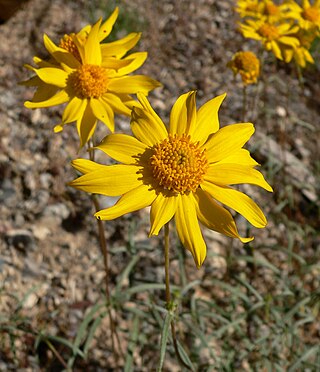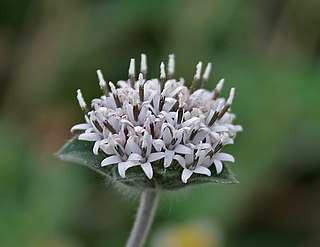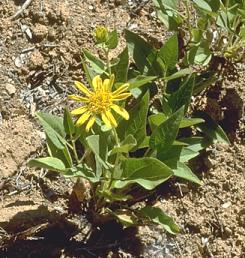
Asterales is an order of dicotyledonous flowering plants that includes the large family Asteraceae known for composite flowers made of florets, and ten families related to the Asteraceae. While asterids in general are characterized by fused petals, composite flowers consisting of many florets create the false appearance of separate petals.

Asteraceae is a large family of flowering plants that consists of over 32,000 known species in over 1,900 genera within the order Asterales. The number of species in Asteraceae is rivaled only by the Orchidaceae, and which is the larger family is unclear as the quantity of extant species in each family is unknown. The Asteraceae were first described in the year 1740 and given the original name Compositae. The family is commonly known as the aster, daisy, composite, or sunflower family.
Harold Ernest Robinson was an American botanist and entomologist.

The Heliantheae are the third-largest tribe in the sunflower family (Asteraceae). With some 190 genera and nearly 2500 recognized species, only the tribes Senecioneae and Astereae are larger. The name is derived from the genus Helianthus, which is Greek for sun flower. Most genera and species are found in North America and South America. A few genera are pantropical.

Venegasia is a genus of North American plants in the tribe Madieae within the family Asteraceae.

Heliopsis is a genus of herbaceous flowering plants in the family Asteraceae, native to dry prairies in North and South America. The sunflower-like composite flowerheads are usually yellow, up to 8 cm (3 in) in diameter, and are borne in summer. Species are commonly called ox-eye or oxeye.

Helianthella, the little sunflower, is a genus of North American plants in the family Asteraceae.

Pseudogynoxys is a genus of flowering plant in the groundsel tribe within the sunflower family, native to North and South America.

Psilostrophe, the paperflowers is a genus of North American plants in the sneezeweed tribe within the sunflower family.

Geraea is a genus of the family Asteraceae from the southwestern United States and northwestern Mexico, commonly called the desert sunflower.

Heliomeris is a genus of flowering plants in the family Asteraceae, known generally as false goldeneyes.

Thelesperma is a genus of North American and South American plants in the cosmos tribe within the sunflower family. Greenthread is a common name for plants in this genus.
Alvordia is a genus of flowering plants in the family Asteraceae. It includes 4 species of shrubs which occur in the states of Baja California and Sonora, Mexico. The genus is characterized by having a secondary clustering of heads into compound units, so that what appears to be a single head is actually a group of heads packed together. The genus is classified as a member of subtribe Helianthinae, the same subtribe that contains the common sunflower (Helianthus). Based on the reported chromosome counts, Alvordia includes both diploid and polyploid species, but the relationships among these have not yet been studied in detail. No chromosome count has yet been reported for the species A. congesta from Sonora, which was a later transfer to the genus.
Dugesia is a genus of flowering plants in the family Asteraceae.
Henricksonia is a genus of flowering plants in the daisy family.

Lagascea is a genus of flowering plants in the family Asteraceae. It occurs primarily in Mexico, but some species extend into Central America and one reaches north into the western United States. One species, L. mollis, has been widely introduced to other localities around the tropics and subtropics.

Chrysactinia is a genus of flowering plants in the family Asteraceae, native to Mexico and to the southwestern United States.

Agnorhiza is a small genus of flowering plants in the family Asteraceae described as a genus in 1998. Its species had previously been considered members of either Wyethia or Balsamorhiza. The plants are native to California, with the range of one species (A. ovata) extending into northern Mexico. They are perennial herbs with sunflower-like flower heads 1 to 4 centimeters wide.
Cotula mexicana, also known as Mexican brassbuttons, is a plant species in the sunflower family. It is widespread in South America and also found in central Mexico and parts of the United States.
Heliopsis buphthalmoides is a New World species of flowering plant in the family Asteraceae. It is the only member of its genus native to both North America and South America. It is found in Mexico, all 7 countries of Central America, and western South America.













